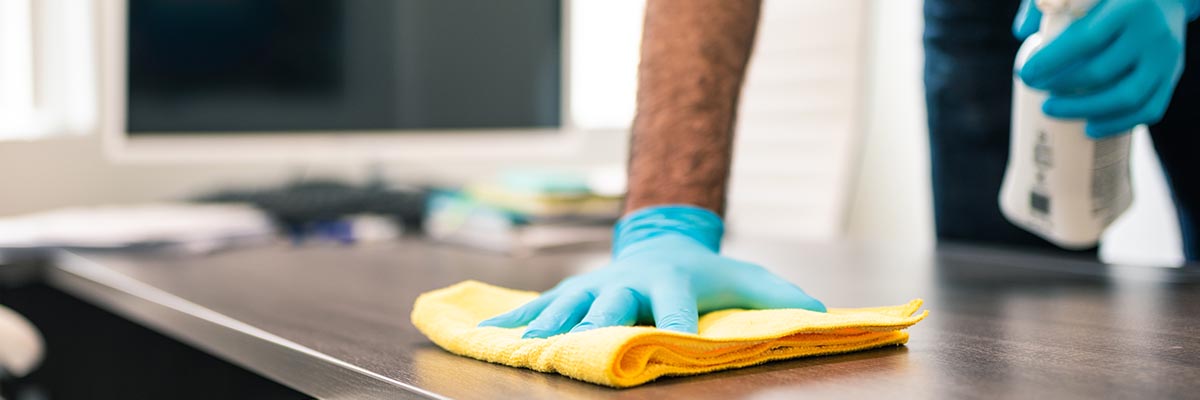Understanding the Differences Between Disinfecting, Sanitizing, and Cleaning
Facility managers face numerous responsibilities, including ensuring a clean and safe environment. A key part of this responsibility is understanding the differences between cleaning, sanitizing, and disinfecting—a distinction that has significant implications for maintaining health and compliance. This article will clarify these terms, outline when and where each process is appropriate, and provide actionable insights for effective facility management.

By the end of this article, you’ll have a comprehensive understanding of these essential cleaning processes and their impact on the health of your facility. Keep reading to discover how these practices can elevate your facility’s cleaning protocols and improve outcomes.
What is Cleaning?
Cleaning is the process of removing dirt, debris, and other impurities from surfaces. It primarily focuses on aesthetics and surface-level hygiene by using detergents and mechanical action to physically remove contaminants. While cleaning can reduce the presence of germs, it does not kill bacteria or viruses, making it the foundational step for further sanitizing or disinfecting.
When to Clean
Cleaning is appropriate for routine maintenance and preparing surfaces for sanitizing or disinfecting. It is ideal for removing visible dirt from high-traffic areas, public spaces, and shared equipment. Cleaning should also be the first step before applying sanitizers or disinfectants to ensure their effectiveness.
What is Sanitizing?
Sanitizing reduces the number of germs on surfaces to a safe level, as defined by public health standards. It targets bacteria more than viruses, making it a critical step in environments like kitchens, cafeterias, and break rooms. Sanitizers are often used in conjunction with cleaning agents to ensure safety and compliance.
How Sanitizing Differs from Cleaning
While cleaning focuses on removing debris, sanitizing focuses on lowering the germ count to safe levels. It is not intended to kill all germs but to reduce the risk of illness. This makes sanitizing especially useful in food preparation areas and spaces with frequent human contact.
What is Disinfecting?
Disinfecting involves using chemical agents to kill nearly 100% of bacteria and viruses on surfaces. It is the most effective method for preventing the spread of infectious diseases. Disinfectants must be applied to clean surfaces to work effectively, and they require appropriate dwell time to achieve maximum germ-killing potential.
Key Applications for Disinfecting
Disinfecting is essential in healthcare settings, restrooms, and any areas with a high risk of infection. It is also critical during illness outbreaks or in response to a confirmed case of infectious disease. Proper disinfecting protocols can significantly reduce the risk of cross-contamination in high-touch areas.
Products for Each Process
Cleaning Products
Cleaning requires tools like microfiber cloths, mops, and general-purpose cleaners. The goal is to physically remove dirt and grime without necessarily targeting microorganisms. Regular maintenance with the right tools ensures an aesthetically clean facility.
Sanitizing Products
Sanitizing often involves food-safe products approved by regulatory agencies. Spray sanitizers and wipes are commonly used for tables, countertops, and other surfaces that come into direct contact with people. Facility managers should ensure that products are compatible with the surfaces being treated.
Product Spotlight
Hillyard H-129 Sanitizer - Hillyard H-129 Sanitizer is a highly effective solution for sanitizing both food contact surfaces, such as utensils, countertops, and refrigerated equipment, and pre-cleaned non-food contact surfaces like floors and restroom surfaces. Its concentrated formula is ideal for 3rd sink food contact surface sanitization, offering economical cost-in-use. NSF approved and Kosher Certified, it meets high standards for safety and compliance.

Disinfecting Products
Disinfecting requires appropriate tools and products to kill germs on surfaces effectively. Sprayers, wipes, and other application methods are commonly used to distribute disinfectants evenly over surfaces. Following the manufacturer’s instructions for dwell time and dilution is essential to ensure the disinfectant achieves its intended effectiveness. Disinfection is particularly important in restrooms, healthcare facilities, gyms, schools, daycare centers, and other high-traffic or high-touch environments.
Product Spotlight
Hillyard Re-Juv-Nal Disinfectant Cleaner - Re-Juv-Nal is a phosphate-free disinfectant cleaner with a safe-for-surfaces pH of 5.5-7.5, providing effective cleaning, deodorizing, and disinfection for a wide range of facilities, including hospitals, schools, and food service establishments. It is designed for hard, non-porous surfaces like floors, walls, stainless steel, and tile, and requires rinsing with potable water for surfaces that contact food. Re-Juv-Nal is highly effective, killing SARS-CoV-2 (COVID-19 virus) on treated surfaces in just one minute while leaving a pleasant floral scent.
Best Practices for Facility Managers
Facility managers should establish clear cleaning protocols that differentiate between cleaning, sanitizing, and disinfecting. Training staff on the appropriate use of cleaning agents and tools is critical for compliance and effectiveness. Regular audits and documentation help ensure that standards are consistently met.
Creating a Cleaning Schedule
A well-planned cleaning schedule categorizes areas by risk level, assigning cleaning, sanitizing, or disinfecting as appropriate. For example, restrooms and break rooms may require daily disinfection, while general offices may only need routine cleaning and periodic disinfection. Scheduling ensures resources are used efficiently while maintaining a healthy environment.
Hillyard Can Help
Hillyard’s nationwide team of experts is ready to assist you in developing effective cleaning, sanitizing, and disinfecting programs tailored to your facility’s needs. We evaluate your unique challenges, such as surface types, traffic patterns, and high-touch areas, to recommend the most appropriate products and methods. In addition to providing the right solutions, Hillyard offers hands-on training to ensure your employees are confident and equipped to follow best practices. This comprehensive support helps your team work efficiently while maintaining the highest standards of safety and cleanliness. With Hillyard, you gain not only the right tools but also the knowledge to implement them effectively. Use the “I’m Interested” form below, and one of our experts will contact you to get started.
Frequently Asked Questions
What is the difference between sanitizing and disinfecting?
Sanitizing reduces germs to safe levels as defined by public health standards while disinfecting kills nearly 100% of germs, including bacteria and viruses. Disinfecting is generally more thorough and is required in high-risk areas.
How often should high-touch areas be disinfected?
In high-traffic facilities, high-touch areas like doorknobs, handrails, and elevator buttons should be disinfected more frequently. The frequency should be increased during outbreaks or flu season. Daily disinfection is a common practice during these times.
Can one product be used for cleaning, sanitizing, and disinfecting?
Some products are formulated to perform multiple functions, but they must be used as directed to achieve specific results. For example, a cleaner-disinfectant may require a cleaning step when visible soil is present, followed by a specific dwell time to disinfect effectively.